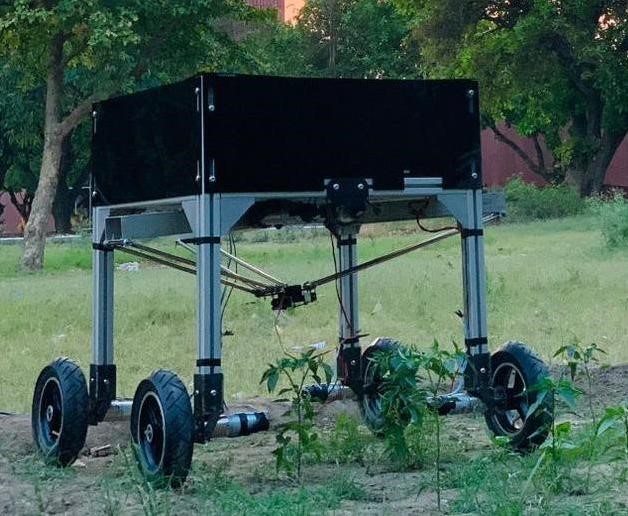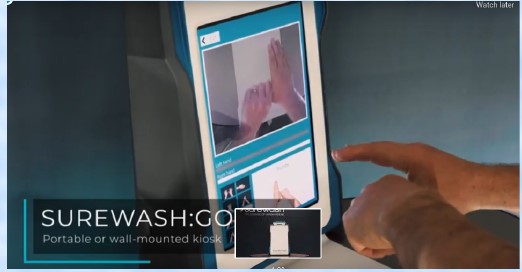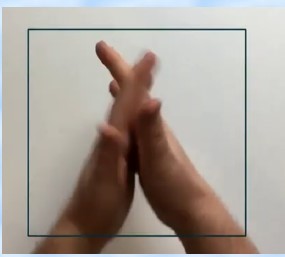Faculty Achievements
Product Development/ Working Model
- Product Developed: Wearable Health Activity Tracker Device
Name of Faculty: Dr. Prashant Singh Rana, Associate Professor, CSED
Objective:
The objective of this project is to design and develop a wearable health activity tracker device that will enable individuals to monitor and track their health and fitness metrics in real time. The device will provide accurate data on various parameters, including heart rate, SpO2% body temperature, and ECG. By collecting and analyzing (Using AI/ML) this information, users can gain valuable insights into their overall health and make informed decisions to improve their well-being.
Methodology:
- Research and Analysis:
Conduct a comprehensive review of existing wearable health and activity tracker devices to understand the latest technological advancements and user requirements. Identify the key features and functionalities that are most desirable to users, such as accuracy, comfort, durability, battery life, and data synchronization capabilities.
- Hardware Development:
Design and develop the wearable device. Consider factors such as form factor, ergonomic design, and materials to ensure optimal user experience and comfort. Incorporate sensors, such as an accelerometer, heart rate monitor, and gyroscope, to capture relevant health and activity data accurately. Select appropriate wireless communication protocols for seamless data transmission and connectivity with smartphones and other devices.
- Software Development:
Create a user-friendly mobile application that will sync with the wearable device. The application should provide a visually appealing and intuitive interface for users to view and analyze their health and activity data. Implement algorithms and machine learning techniques to process and interpret the collected data, providing users with actionable insights and personalized recommendations to improve their health and fitness.
- Testing and Validation:
Conduct rigorous testing to ensure the accuracy and reliability of the wearable device and mobile application. Evaluate the device's performance under different conditions, including various physical activities, sleep patterns, and environmental factors. Seek feedback from a diverse group of users to refine the design and functionality based on their needs and preferences.
Outcome:
The successful completion of this project will result in the development of a cutting-edge wearable health and activity tracker device that offers the following outcomes:
- Real-time monitoring:
Users will have access to real-time health and activity data, empowering them to make informed decisions regarding their lifestyle choices and physical well-being.
- Personalized insights:
The device will provide personalized insights and recommendations based on user's health and activity data, enabling them to set achievable goals and track theirprogress effectively.
- Improved health outcomes:
By tracking key health metrics, users can proactively manage their health, leading to improved overall well-being, increased physical activity, and better sleep habits.
- User-friendly interface:
The mobile application will provide an intuitive and visually appealing interface, enhancing user engagement and encouraging long-term usage of the wearable device.
- Enhanced data analysis:
The integration of advanced algorithms and machine learning techniques will enable the device to deliver accurate and actionable insights, leading to more effective health and fitness management.
Final Product
Conclusion:
The project aims to develop a wearable health activity tracker device that empowers individuals to take control of their health and well-being. Through meticulous research, hardware and software development, rigorous testing, and user feedback, we expect to deliver an innovative solution that will have a positive impact on individuals' lives, fostering healthier lifestyles and improved overall fitness.
- Product Developed: AgriRover
Name of Faculty: Dr. Karun Verma, Associate Professor, CSED
Utility: Weed detection and its treatment.

This project encompasses several components and achieves a Technology Readiness Level (TRL) 3 by effectively addressing the issue of weed identification in the agricultural domain. The developed platform is meticulously engineered to minimize the labor-intensive and time-consuming aspects associated with conventional weed management practices. The initial study focuses on the collection of multispectral and RGB data from a rice field, encompassing crops, weeds, and disease data. As part of the analysis, various vegetation indices are computed and examined for both healthy crops and identified weeds present in the field. A successful outcome of this study involves the creation of weed maps using supervised learning techniques applied to aerial imagery of the field, with accuracy assessment based on ground data collection.
The weed identification system is conceived through the collection of RGB and multispectral samples of weeds and crops in rice fields. Visual features of the weeds are extracted from the collected RGB samples and multispectral signatures, which are then utilized to train a YoloV5-based system capable of distinguishing weeds from healthy crops. Additionally, the Lincoln beetroot dataset is utilized to further train the weed identification system. The system undergoes successful accuracy testing, with weeds being identified with an 80% confidence level. The technology can be further enhanced and adapted to improve the classification accuracies of the models by incorporating additional data.
Furthermore, this weed identification technology can be implemented on a semi-autonomous vehicle designed to systematically scan entire fields planted with row crops. The purpose of this vehicle is to identify weeds and administer precise treatments in-situ while scanning the field.
Furthermore, this weed identification technology can be implemented on a semi-autonomous vehicle designed to systematically scan entire fields planted with row crops. The purpose of this vehicle is to identify weeds and administer precise treatments in-situ while scanning the field. As a pre-work on this semi-autonomous vehicle, a prototype design has been developed in the lab and testing is currently in progress.
(C) Product Developed : Software as a Service (SaaS): 360 Degree View
Name of Faculty: Dr. Vinay Arora, Associate Professor, CSED
Software as a Service (SaaS): 360 Degree View
Utility: 360 Degree View of Amenities at Thapar Institute, Patiala Campus; https://tiet360.thapar.edu
Brief Write-up about the utility:
A SaaS-based 360-degree view has been implemented at Thapar Institute in Patiala to provide a comprehensive and immersive experience of the institute's amenities. By utilizing a cloud-based system, users can access the platform quickly, ensuring efficient and seamless navigation. This technology enables stakeholders to virtually explore and interact with various facilities, including libraries, laboratories, sports complexes, and student accommodations, gaining a complete understanding of the institute's infrastructure. The 360-degree view offers a convenient and engaging solution for prospective students, faculty, and other visitors to explore Thapar Institute's amenities remotely.
Participants/Team: A team of 04 from CSE department has designed and developed the 360 Degree View SaaS. Details are as follows:
Prof. Maninder Singh (Dean of Academic Affairs, T.I.E.T), Professor, CSED
Dr. Vinay Arora (Associate Dean of Academic Affairs, T.I.E.T), Associate Professor, CSED
Shubhankar Sharma and Lakshya Gupta (3rd Yr., Batch 2021-2025)
(D) Product Developed: Hand hygiene software
Name of Faculty: Dr. Jhilik Bhattacharya , Associate Professor, CSED
Company name : Surewash, Ireland
About the company:
SureWash is part of GLANTA, founded in 2011, GLANTA has been developing new techniques in gesture recognition and augmented reality since the beginning. GLANTA’s mission is to deliver working applications for camera based algorithms. SureWash hand hygiene training technology is the perfect example.
Product description:
SureWash uses technology to teach hand hygiene with interactive training devices having a live video camera to assess the users hand hygiene technique. To help users improve their technique, real-time feedback is also provided throughout the training. The software implementation mainly deals with capturing the live camera feed containing the hand image of the users. Hand detection in the camera frame and hand hygiene gesture classification is carried out using deep learning algorithms and feedback is displayed to the user.


Utility and users: The product is installed in various hospitals around the world to maintain hygiene and reduce infections.
(E) Product Developed : Intelligent Blood Extraction Device
Any Research Laboratory (s) Developed since July 2020 to Till date (Yes/No)
Lab Setup from ICMR sponsored (Location: L-512)
Project Title: Development of an Intelligent Blood Extraction Device
Investigators: Dr. Harpreet Singh, Neeru Jindal and and Dr. Prashant Singh Rana
Partner Institute: PGIMER, Chandigarh
Project Duration: 3 years (2021 – 2024)
Project Budget: 35.05 lakhs
Project Summary
The present invention discloses a portable, light weight and a precise fully automatic wearable blood extraction device that is worn on the arm of the person. It contains an embedded electronic system that includes a preprogrammed microcontroller “Arduino lily pad” that controls each and every action of the device automatically. The device contains high definition cameras for thermal imaging the veins. The veins are prioritizes by taking captured images as input and vein with highest blood flow and nearer to skin is automatically selected. The microcontroller then actuates the mover that moves around the arm and detects a venipuncture point. The mover that contains syringe injects it into the skin and extracts the required quantity of blood. The present invention is easy to use as no assistance is required for taking blood sample and blood is automatically extracted.
Objectives
- To prepare new image database of Indian patients for the proposed work.
- To develop a portable, light weight and a wearable automated blood extraction device.
- To develop the framework in the device which enhance the automation by prioritize veins and extracts blood in consistent, robust and efficient manner.
- To test and validate the effectiveness of proposed device clinically.
Background
Diagnostic blood testing is the most common medical routine performed in the world. In the U.S., blood tests are performed 2 billion times each year. However, blood draw success rates depend heavily on practitioner skill and patient physiology, and diagnostic results are generated in centralized labs from large-volume blood samples using labor-intensive analytical techniques. Proposed work discloses a portable, light weight and a precise fully automatic wearable blood extraction device.
Developed Product
Lab Equipments
Methodology
The present invention discloses a portable, light weight and a precise fully automatic wearable blood extraction device that is worn on the arm of the person. It contains a processing unit which is a microcontroller -“Arduino- lily pad” fixed on the device. The actuation and controlling of the other mechanical components inside the device is done using microcontroller that makes it working automatic. The microcontroller is fixed outside the device trough which input and output is received and send to device. Following steps are used:
- The blood extraction device is worn on the arm of the patient. The palm switch detects the arm and switches ON the circuit.
- The user enters the amount of blood sample required by entering the value using keyboard.
- Three LED panels glow and high definition thermal cameras scan the arm.
- The cameras send the captured picture to processing unit which is “Arduino-lily pad” that processes the images and detects the best vein on which venipuncture can be done.
- Vein with highest priority, maximum, blood flow, most clear image and nearer to skin will be selected that minimized the chances of injury.
- If the vein is not selected from upper arm then device check the same conditions in forearm near the palm.
- The device then checks the number of available syringes and if syringes are available. Microcontroller moves the mover to puncture the vein. If syringes are not available then refilling of the syringes is done in syringe reserve channel.
- For puncturing the vein, the microcontroller detects the X and Y coordinates of the puncture and moves the mover to that point. Mover is moved by coordination of motor and motor that moves mover using X-axis ring and Y-axis shaft. Friction free movement is provided to mover as a bearing couple ring is provided that transfers the X-axis motion of mover to parallel ring on other side.
- Mover is responsible for extraction of blood from the human body autonomously.
- As mover adjusts to venipuncture point coordinates, stepper motor moves one step to push the syringe from syringe reserve channel towards inclined channel which is inclined at 30 degree or less and permanent magnet attracts the syringe to syringe holder and fits into it.
- The electromagnet receives signal form processing unit and turns ON and moves Magnet (M2) towards Magnet (M1).
- Magnet (M2) slides towards magnet (M1) and joins with magnet (M1) that makes connection of syringe holder with capillary tube.
- Blood can be now extracted through capillary tube due critical vacuum pressure created by vacuum chamber.
- The blood is taken out due to suction pressure and is sent to test tube through capillary tube.
- Vacuum valve is closed and reverse current is flowed through electromagnet to repel the syringe and send it to the syringe disposal section.
- After all processing stages, the model equipment based on 30 numbers of patients of proof of concept will also be prepared.
Expected Output and Outcome of the proposal
- Main anticipated outcome of the project is to develop a portable, light weight and a precise fully automatic wearable blood extraction device that is worn on the arm of the person.
- Industrial consultancy
- Simultaneously it is anticipated that one doctoral degree can be produced from the project.
- Last but not the least, patent filing and some publications in reputed journals.
Consultancy (from Industry)
2019-20
|
Project Title |
Duration |
Funding Agency |
Amount (in Rupees) |
|
Hand Hygiene for Surewash |
1 Year |
Surewash Glar |
200000 |
|
|
|
|
Total Amount 200000 |
Cumulative Amount: 200000